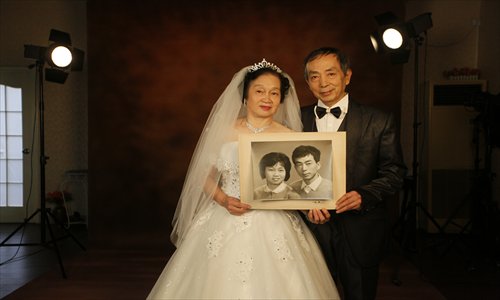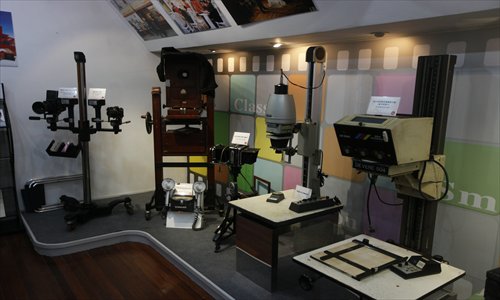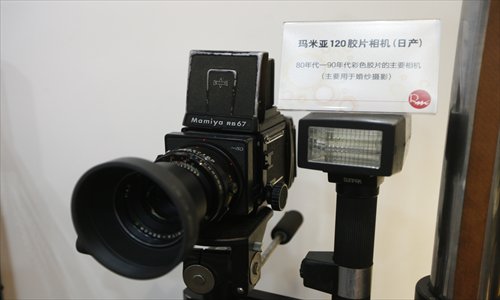A changing focus

When 66-year-old Mr Wang brought his wife to a photographic studio hidden in a quiet lane on Julu Road last week, he didn't expect to see the place crowded with senior citizens. Wang is a romantic husband and arrived at the studio with a set of seven black and white wedding photos which were taken on March 5, 1981. He wanted to have his now 63-year-old bride don her wedding gown again and recreate the moment for the camera.
Wang was inspired by hearing that the studio, formerly the Renmin Photo Studio and now Shanghai New People Photograph Company, was offering old customers the chance to recreate their wedding day pictures for free. He and his wife had carefully preserved their original wedding photos which had cost them 32 yuan ($5.25) 30 years ago. The pictures show a happy couple, the bride in a tailor-made satin wedding gown with a white veil and the groom in a formal dark suit - a throwback to the olden days of Western wedding photographs.
The photographs capture a moment in time and photographers have been doing this in Shanghai since the 1840s when the first Western photographers arrived here - in those days with bulky equipment, chemicals and glass plates to make their Daguerreotype images.
In John Hannavy's book, Encyclopedia of Nineteenth-Century Photography, Terry Bennett talks about one of the key early pictures from Shanghai - the picture, a portrait of Mongol Prince Sengge Rinchen, was taken by Chinese photographer Lai Chong in 1853. Four years later Frenchman Louis Legrand was running a watch and clock-making business and a photo studio in the city offering portraits for the newly minted society people of the day. He later branched into 3D portraits and in 1859 produced a series of 3D scenes of Shanghai which proved popular in Europe.
Photography in those early days was difficult. It involved cumbersome equipment and dangerous chemicals (not made safer by the extreme temperatures encountered here), and few Westerners were allowed to travel outside of the Treaty Ports. As society became more sophisticated and the cameras and processing developed as well, photographic studios became one of the regular businesses of Shanghai.

The detective photographer
By the early part of the 20th century photography was commonplace and wedding photography was a requisite for both Western and Chinese couples. But not all photographers stayed in their studios. Detective William Armstrong was the Director of the Criminal Investigation Department of the Shanghai Municipal Police between 1918 and 1927 and, although not a professional photographer as such, produced some of the most amazing images of the period.
In the 1930s the Chinese photographer Lang Jingshan brought an artistic tradition to his pictures - his shanshui (landscape) photographs involved new techniques and broke new ground. Another prominent photographer was Sha Fei who was active during the War of Resistance against Japanese Aggression (1937-45) and captured some stunning war images.
Later major influences on photography in China included Hou Bo and her husband Xu Xiaobing who were Mao Zedong's official photographers. Her photo of Mao and the new leaders on October 1, 1949, proclaiming the founding of the People's Republic of China, became one of the most published pictures of the century.
Although the cameras have changed, the traditions of studio photography in Shanghai continue today, but most of the State-owned photo studios have been closed or privatized. The Shanghai New People Photograph Company is the only State-owned photo studio still operating in the city.
The studio was opened by a Russian businessman at 144 Route Vallon (now Nanchang Road) in 1940, moving to 131 Route Cardinal Mercier (Maoming Road South) in 1947.
Just before the foundation of the People's Republic of China, the studio was bought by a Chinese employee, Gu Yunming, and renamed it Qiaoshi Photograph Company.
During the 1950s, the photo studio was popular with local celebrities like the film stars Bai Yang and Zhao Dan, the artists Liu Haisu and Zhu Qizhan and the popular writer Ba Jin. Rong Yiren, the one-time Vice President of the People's Republic of China, asked photographers from Qiaoshi to photograph his daughter's wedding day. A portrait by Italian photographer Giorgio Lotti, who took a famous photograph of Zhou En'lai, China's first premier, still hangs on the wall in the studio.
The studio moved to 831 Huaihai Road Middle in September, 1959 and was again renamed the Renmin Photo Studio on National Day that year. It opened a branch at 302 Huaihai Road Middle in 1985.
In the 1980s, the Renmin Studio launched a new approach to studio portraits. Zhang Jianjun, the deputy general manager of the studio today, told the Global Times: "After the central government launched the reform and opening-up policy, more and more Shanghainese came here for photographs, especially for weddings and family pictures."
Fashion trends
The studio on the corner of Maoming Road South and Huaihai Road Middle became something of an attraction in itself with people from all over the city visiting its window displays to see the latest trends in fashion, hairstyles and makeup. In those days even though Huaihai Road was as busy as ever, neon lighting and advertising signage were still a rarity - Renmin's displays were ahead of the times.
"The interior of Renmin's three-story flagship on Huaihai Road was created by a foreign design company and we renewed the window display every three or four months to keep it up-to-date," Zhang, a 40-year veteran with the company, said proudly.
Renmin had its peak business in the 1990s after it expanded its business to include photo processing and film retailing - the period when many Shanghai homes bought their own cameras. It became the sole agent for Kodak in the Asia-Pacific region. It also developed X-rays for city hospitals.
"At that time we were making more than 100 million yuan a year," Zhang recalled, way ahead of most other city businesses. Later, Renmin merged with two other local photo studios, Dongfang and Dielai, to become today's Shanghai New People Photograph Company.
Gu Yunxing, the studio owner Gu Yunming's younger brother, was a major figure in the company, joining Qiaoshi after graduating from university to learn about photography and business.

Classic paintings
With a good command of English, French and Russian, Gu Yunxing was a Chinese businessman who blended art, culture and painting into photography. In the 1950s he blended classic Western oil painting styles into his photographic portraits. "To present a perfectly balanced portrait, lighting is very important," Chen Linxing, the company's art director explained.
Chen began as an apprentice 30 years ago learning every aspect of photography. Shadows and lighting are vital for good photography, he said. And after that processing was crucial. "Back then we didn't have Photoshop so every photo was revised manually."
The studio used a special editing box which allowed the photographers to adjust the negatives with a special pencil, a technique that required a lot of skill and patience. In the 1960s the studio asked the Shanghai Animation Film Studio to create a series of backgrounds for it to use.
After Gu, Yin Mengzhen became the soul of Renmin in the 1960s devoting herself to wedding photography. Her work in this field through the 1980s and 1990s has been curated by the former Shanghai Art Museum in a permanent collection - she is the first and only artist so far to be honored like this.
When Huaihai Road was redeveloped in 1997, Renmin moved to its current shikumen lane house on Julu Road but this presaged a decline in business.
By 2000 the city saw scores of modern wedding photography studios open along Huahai Road. However Renmin continues to thrive, partly because it has some of the most sophisticated processing facilities. "Many of the high-end photo studios on Huaihai Road send their films to us for processing," Shen Yaozhong, the executive vice president of Renmin, told the Global Times.
The company's free wedding photograph recreation was inspired by a call from a 90-year-old American Chinese woman. "She called and asked a lot of questions, wanting to know our original name and original address, to confirm we were the genuine Renmin," said Zhang.
Location problems
The woman had had her wedding photos, her silver wedding anniversary photo and golden wedding anniversary photo taken at the Renmin studio on Huaihai Road. She wanted to come back to Shanghai to have a family photo taken there as well but couldn't find the original studio.
"Her call reminded me that a lot of loyal fans are still looking for us and we've lost contact for too long," Zhang said. That was when the company launched a citywide special offer for its old customers.
The special offer allows any couple who had their wedding photos taken at Renmin, Dongfang or Dielai studios before December 31, 1988 to have a free wedding photo set taken again.
By the end of last week more than 700 couples had signed up. It has proved so popular that Zhang said the studio is now looking for extra wedding dresses and suits suitable for older couples. "We are promising to give them their happiest day all over again."